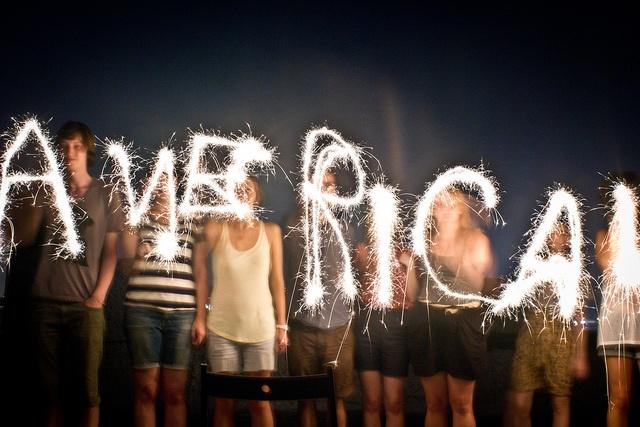
With a busy week behind you and the weekend within reach, there’s no shame in taking things a bit easy on Friday afternoon. With this in mind, every Friday TriplePundit will give you a fun, easy read on a topic you care about. So, take a break from those endless email threads, and spend five minutes catching up on the latest trends in sustainability and business.
If you haven't heard, the U.S. election is on Tuesday. And most of us probably can't wait for it to be over. While the political cycles that defined our country were typified by a hope that tomorrow can be better than today, a dark cloud seems to have settled over this election. The negative rhetoric about America's supposed fall from grace even prompted our neighbors in Canada to remind us we're not so bad after all.
And amidst all this talk about making America great again, it's easy to forget how far we've come as a society. So, before you go hide under your covers all weekend, take a moment to remember the ways America is already great. Here are a few of them.
1. We guarantee civil liberties under the Constitution (which is actually a pretty big deal)
It's hard to turn on a cable news program without someone warning you that your Constitutional rights are under attack. And while the Constitution does indeed evolve over time (as its 27 amendments prove), the civil liberties guaranteed to Americans have remained more or less unchanged -- if not strengthened.
It's also worth noting that, although we often take our founding principles for granted, they're actually quite unique in the world -- even to this day. Take, for example, freedom of the press. The independent watchdog organization Freedom House began publishing its annual Freedom of the Press report in 1980 to analyze the state of the free press around the world. Last year, it found some disturbing results:
"The share of the world’s population that enjoys a free press stood at 14 percent" in 2015. That means only 1 in 7 people lived in countries where coverage of political news is robust, the safety of journalists is guaranteed, state intrusion in media affairs is minimal, and the press is not subject to onerous legal or economic pressures," according to the group.
The figures are equally grim for religious freedom. From the Pew Research Center: "64 nations – about one-third of the countries in the world – have high or very high restrictions on religion. But because some of the most restrictive countries are very populous, nearly 70 percent of the world’s 6.8 billion people live in countries with high restrictions on religion, the brunt of which often falls on religious minorities."
Do we sometimes fall short of our duty to protect and uphold the civil liberties of our peers? Of course. Do we always live up to our standards? Surely not. But it's important to remember that our standards are high standards, particularly when compared to the rest of the world. It's no reason to stop pushing for an even better quality of life, but don't let the media or politicians make you forget how good you really have it. They're likely only doing so to push their own agenda.
2. And we continue to push for greater equality
The past decade brought even greater equality to the American population, although it's surely still a work in progress.
In 2009, the Obama administration inked the Lilly Ledbetter Equal Pay Act, which prohibits sex-based wage discrimination between men and women performing the same job in the same workplace. Of course, the gender pay gap still exists. But this legislation is inarguably a step in the right direction.
The past decade has also seen a sea change in fair and equal treatment for LGBT Americans, culminating in the nationwide legalization of same-sex marriage last summer. And, sparked in part by the Black Lives Matter movement, conversations around structural injustices and racial equity are beginning to amplify -- hopefully laying the ground work to continue breaking down these barriers.
3. We now have the highest high-school graduation rate in history
U.S. students are graduating from high school at a higher rate than ever before, according to data from the U.S. Department of Education's National Center for Education Statistics (NCES). The nation's high-school graduation rate hit 82 percent in 2013-14, the most recent year for which the NCES compiled data.
While graduation rates remain lower for students of color compared to white students, that gap is narrowing. Nearly 73 percent of black students and over 76 percent of Hispanic students graduated high school in 2013-14 -- representing a more than 5 percent increase for both groups since 2010. Rates are also lower for students with disabilities (now around 63 percent), but those figures also rose by more than 4 percent in only three years.
4. Poverty is dropping...
Poverty, though still too high, has now fallen to rates slightly below those of the late 1990s (see Table 2 here). Poverty rates hovered around 13 percent for individuals and 11 percent for families last year. Similar levels were last seen in 1997, before the boom of the late '90s and early 2000s drove them down up to 2 percent more.
The poverty rate remains slightly higher than it was before the 2007-2008 financial crisis (12.5 percent and 10.8 percent for individuals and families, respectively, in 2007). But it has fallen by more than 2 percent since its peak in 2010, after remaining relatively stagnant for both 2011 and 2012.
Again, these figures are far different for people and families of color compared to America as a whole. Black poverty was a shameful 23.9 percent for individuals and 22.1 percent for families last year. These figures are down by over 4 percent since 2010, but still far too high for us to consider ourselves an inclusive economy. The numbers are equally grim for Hispanics (21.4 percent and 20.4 percent, respectively). So on this point we've made progress, but there's still much to be done.
5. ... and so is violent crime
With all of this talk about law and order and our cities slipping into chaos, one would think the statistics would show a boom in violent crime. In fact, the opposite is true.
Today, the national crime rate is about half of what it was at its height in 1991, according to New York University Law School's Brennan Center for Justice. Violent crime fell by 51 percent over the past 15 years, and property crime dropped by 43 percent.
Despite the significant decrease in crime, Americans don't seem to feel much safer walking through their neighborhoods. In a 2014 Gallup poll, the majority of Americans said "there is more crime in the U.S. than there was a year ago." This is an ongoing Gallup trend, and the majority seen in 2014 -- 63 percent -- was actually one of the smallest in 10 years.
6. We're quickly transitioning to a clean-energy economy...
The U.S. solar and wind industries continue to grow, driving the country's transition to a low-carbon, clean-energy economy. The U.S. solar market installed 7.3 gigawatts of solar energy last year, up from a mere 1.9 gigawatts four years earlier. The wind energy industry is also on a steady incline and now powers the equivalent of 20 million American homes.
All totaled, renewable energy accounted for 10 percent of total U.S. energy consumption and 13 percent of energy generation in 2015. That's still a far cry from the Energy Department's goal to source 30 percent renewable energy by 2025. But with the accelerated rate of renewable infrastructure deployment over the past three years, the target may very well be within reach.
7. ... causing a boom in green jobs
Renewable energy employment in the United States reached 724,000 jobs in 2014, a 16 percent increase from the previous year. Those figures reached 769,000 last year.
So, what does that really mean? To put it into perspective, the solar energy industry alone employed 35,000 people in 2015, up 20 percent from the previous year. And solar now employs more people than the oil and gas extraction industries.
8. And a drop in carbon emissions
After increasing in 2013 and in 2014, energy-related carbon emissions fell last year to 12 percent below 2005 levels.
In 2015, the U.S. used 15 percent less energy per unit of GDP and produced 23 percent fewer energy-related CO2 emissions per unit of GDP compared to 2005, according to the Energy Information Administration.
Image credit: Flickr/Michael Dougherty

Mary has reported on sustainability and social impact for over a decade and now serves as executive editor of TriplePundit. She is also the general manager of TriplePundit's Brand Studio, which has worked with dozens of organizations on sustainability storytelling, and VP of content for TriplePundit's parent company 3BL.














